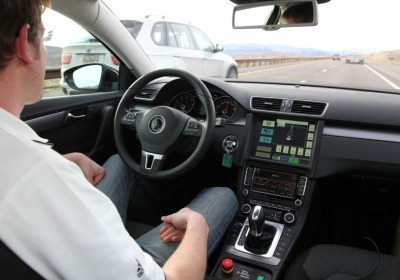Continental developing experimental semiautonomous vehicle
Mon, 26 Mar 2012
A vehicle that drives itself has been a fantasy for many drivers since they encountered their first traffic jam. While a fully autonomous car is not quite here, Continental—yes, the same company that makes tires—has an experimental semiautonomous vehicle that will eclipse the magical 10,000-miles-on-road mark this month.
Its unassuming Volkswagen Passat is fitted with a plethora of safety and technology systems that the company has been developing and tweaking over the course of the project.
A group of automotive journalists were invited to the Continental Brimley Development Center in Brimley, Mich., in February to see firsthand the individual technologies that are pressed into duty in its fleet of driver-assist cars.
While other companies work to create a fully automated car with new technology, Continental has relied on its existing “off the shelf” tech for the project. These efforts not only reduce costs but also the amount of time it will take to go from tests to full-scale implementation.
Engineers who relocate north for winter to work at Continental's development center in Michigan's Upper Peninsula prepared the fleet for our arrival.
Vehicles equipped with a short-range LIDAR (light detection and ranging) system and/or LIDAR with the addition of a camera were repeatedly able to stop prior to hitting obstacles during road tests, even from speeds of up to 45 mph. On approach, the LIDAR system works to identify potential obstacles. Once a “point of no return” is passed, the system engages the brakes and stops the car before impact, albeit with just inches to spare. Behind the wheel the incident is mostly drama-free—while the car stops suddenly, it isn't the kind of sudden, violent stop that reminds you of a B-rated action film. There are no squealing tires and no locked brakes; just firm, controlled stopping.
Features on other cars included a full-speed-range Active Cruise Control currently in use by Mercedes-Benz, an experimental Emergency Steer Assist system that helps drivers swerve to avoid hazards and stay on the road, and a force-feedback accelerator pedal to encourage efficient driving habits. The systems are not intrusive or unsettling, and all can be overridden by driver input. All of the safety systems will defer to the driver's inputs. Other experimental systems included a vehicle furnished with a multitude of indicators to alert drivers of impending collisions or safety-equipment activation. When approaching an obstacle, the vehicle emits both visual and audible warnings and other stimuli are activated, such as seat-shaking and window-closing.
Firsthand experience with each technology was a welcome primer for our time viewing a car with the full suite of technologies.
The semiautonomous, technology-laced Passat is outwardly humble. Don't expect any big whirligigs or obnoxious add-ons to indicate otherwise.
While we were not able to experience the vehicle on public roads, there was no shortage of film demonstrating the car as it drove down both highways and through the city streets of Las Vegas.
Once the car is under way, the aforementioned LIDAR-and-camera combination “looks” for potential hazards or other vehicles in its field of view and the car reacts to them accordingly. On the highway, the car can, and did, change lanes, avoid construction cones, navigate around slower vehicles and operate in a stop-and-go traffic jam on its own accord.
“We consider it a driver-assist technology,” said Ibro Muharemovic, lead engineer for Continental's advanced engineering unit. “The system can assist in heavily congested traffic situations or even out on the open road, lessening driver fatigue.”
Prior to our arrival in Brimley, the team from Continental drove the car from Las Vegas to Michigan, and much of the driving was handled by autonomous systems.
“We would drive eight to 10 hours a day, and at the end of it, we were far less fatigued than if we had been ‘driving' it the whole time,” said Muharemovic. “While we don't realize, it takes an immense amount of concentration and effort when driving long distances. It can get very boring and be very draining.”
When the car reaches the 10,000-mile mark, more than 6,600 miles will have been under autonomous control, according to Continental.
Continental has worked with the National Highway Traffic Safety Administration on the continued development of advanced car-to-car communication technologies that will enhance the functionality of their systems should they reach the mainstream.
While we might still be decades away from fleets of flying cars and pneumatic tubes for use as personal transport, Continental—through the use of today's technology—might have substantially reduced the amount of time between the present and the day when drivers can commute in fully-autonomous cars.
Check out the video to see the car in action.
By David Arnouts

